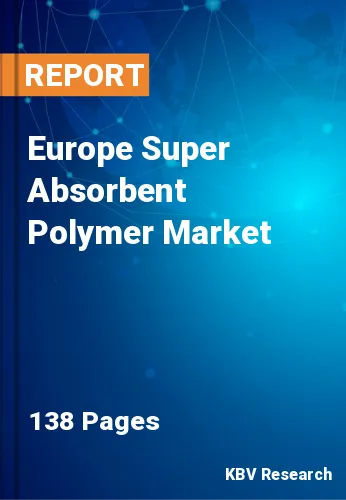
The Europe Super Absorbent Polymer Market would witness market growth of 6.2% CAGR during the forecast period (2023-2030). In the year 2020, the Europe market's volume surged to 413.9 kilo tonnes, showcasing a growth of 4.1% (2019-2022).
SAPs are also used in various hygiene products, such as sanitary napkins, nursing pads, and wound care products. SAPs' moisture-absorbing ability aids in maintaining a dry and comfortable environment, lowering the risk of skin irritation. SAPs are used in the form of fire-retardant gel. When mixed with water, these gels create a viscous substance that adheres to surfaces and slows the spread of fires. The gel can be applied to structures or vegetation, providing a protective barrier. SAPs are used in horticulture and landscaping to improve water retention in soil for potted plants or landscaping projects. This helps reduce watering frequency, conserve water resources, and promote healthy plant growth.
SAPs are sometimes added to concrete mixtures to enhance the properties of concrete. Including SAPs can improve workability, reduce cracking, and enhance the durability of the concrete. SAPs are used in the oil and gas industry for water control in drilling fluids. By absorbing and retaining water, SAPs help prevent water influx into oil wells, maintaining the integrity of drilling operations. In the food industry, SAPs may be used in food packaging to control moisture levels and extend the shelf life of certain products. This is especially crucial for products susceptible to moisture and requiring an extended period of freshness. SAPs are utilized in the textile industry for various applications, including water-absorbing agents in textile manufacturing processes or moisture-wicking sportswear fabrics.
The growing senior population in Germany will likely drive the demand for these products, thereby increasing the use of SAPs. With a larger senior population in Germany, there is an increased demand for high-performance incontinence products that provide effective absorption, comfort, discretion, and skin-friendliness. As per Destatis, 2020, since younger birth cohorts also show decreasing numbers of people, over 65-year-olds make up an ever-larger proportion of the total population over time. It rose from 15% in 1991 to 22 % in 2019. The group of the very old, above 85, is particularly fast growing. Their number increased from 1.2 million in 1991 to 2.4 million in 2019. All these factors will uplift the regional market’s expansion in the coming years.
The Germany market dominated the Europe Super Absorbent Polymer Market by Country in 2022 and would continue to be a dominant market till 2030; thereby, achieving a market value of $672.4 Million by 2030. The UK market is exhibiting a CAGR of 5.3% during (2023 - 2030). Additionally, The France market would showcase a CAGR of 7% during (2023 - 2030).
Based on Type, the market is segmented into Sodium Polyacrylate, Polyacrylate/Polyacrylamide, and Others. Based on Application, the market is segmented into Personal Hygiene, Agriculture, Industrial, Medical, and Others. Based on countries, the market is segmented into Germany, UK, France, Russia, Spain, Italy, and Rest of Europe.
Free Valuable Insights: The Global Super Absorbent Polymer Market will Hit $12.6 Billion by 2030, at a CAGR of 6.4%
The market research report covers the analysis of key stakeholders of the market. Key companies profiled in the report include BASF SE, LG Chem Ltd. (LG Corporation), Formosa Plastics Group, Evonik Industries AG (RAG-Stiftung), Kao Corporation, Sanyo Chemical Industries, Ltd., Songwon Industrial Co., Ltd., Nippon Shokubai Co., Ltd., Sumitomo Seika Chemicals Co. Ltd., and Chase Corporation.
By Type (Volume, Kilo Tonnes, USD Billion, 2019-2030)
By Application (Volume, Kilo Tonnes, USD Billion, 2019-2030)
By Country (Volume, Kilo Tonnes, USD Billion, 2019-2030)
Our team of dedicated experts can provide you with attractive expansion opportunities for your business.
